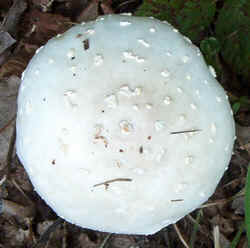 |
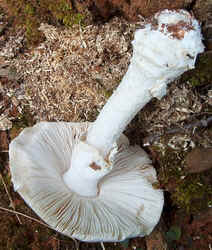 |
|
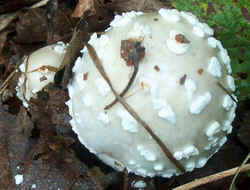 |
||
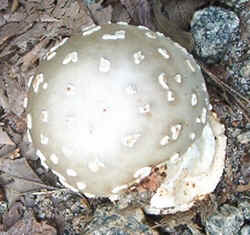 |
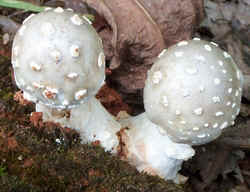 |
Gemmed Amanita
Scientific Name: Amanita gemmata
Family Name: Amanitaceae
Edibility: Possibly poisonous
 |
 |
|
 |
||
 |
 |
Description: Buff-yellow cap with cream patches, ring on stalk, and basal cup attached to stalk or with small, free collar. Cap: 1-4 inches (2.5-10 cm) wide; rounded, becoming convex to flat; margin radially lined; tacky when wet, smooth; pale yellow to buff, with small irregularly placed, cream patches. Gills: free or slightly attached, crowded, broad to narrow, white. Stalk: 2-5 inches (5-12.5 cm) long, 1/4 - 3/4 inches (0.5-2 cm) thick, somewhat enlarged near oval basal bulb; slightly cottony to smooth, white or cream. Veils: universal veil white to cream; leaving patches on cap and stalk base, or basal cup attached to stalk or with free rim at tip of bulb. Partial veil white; often leaving evanescent, pendant ring on upper stalk. Spores: 8.7-11 X 5.5-8.5 microns; broadly elliptical, smooth, colorless, nonamyloid. Spore print white. Edibility: Possibly poisonous. Season: June-October; November-February in California. Habitat: On the ground, in oak and pine woods; woods and parks in urban areas. Range: Throughout North America. Comments: The Jonquil Amanita (A. junquillea) and Russulalike Amanita (A. russuloides) may only be variants of this species. It is thought to have hybridized with the poisonous Panther (A. pantherina) in the Northwest, producing mushrooms with characteristics of both species. The Gemmed Amanita often loses its ring and veil remnants, especially after a rain, and can then be mistaken for a Russula or Tricholoma. This mushroom is sometimes eaten; however, it may well be a species complex, and some of its forms may contain toxins, so it is best avoided. [Lincoff, Gary H., The Audubon Society Field Guide to North American Mushrooms, Alfred A. Knopf, New York, 1981]
Edibility: Edibility unknown. Cap: 3-10 cm wide; convex to nearly flat with age, sometimes slightly depressed in the center; smooth, sticky; pale yellow to pinkish yellow; with white, wart-like patches and shallow grooves near the edge. Flesh thin, soft, white. Gills: Free of the stalk or nearly so, closely spaced; white; covered by a white partial veil in young specimens. Stalk: 5-12 cm long, 5-20 mm thick; equal in thickness overall or enlarging somewhat into a small, rounded, white basal bulb, with a narrow collar; white; with a white ring. Spore Print: White. Fruiting: Solitary or in groups on the ground in conifer and hardwood forests or in grassy areas near pines; summer, fall. Range: Throughout North America. Comments: The white, wart-like patches are easily washed off by rain. [Bessette, Alan and Sundberg, Walter J., Macmillan Field Guides; Mushrooms; A quick reference guide to mushrooms of North America, Macmillan Publishing Company, New York, 1987]